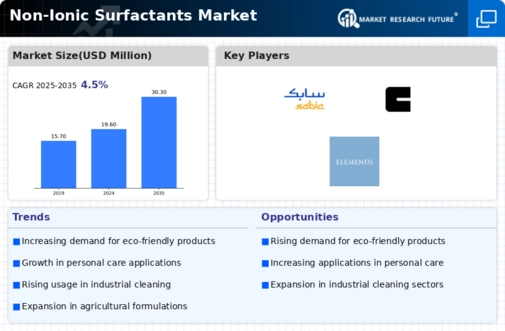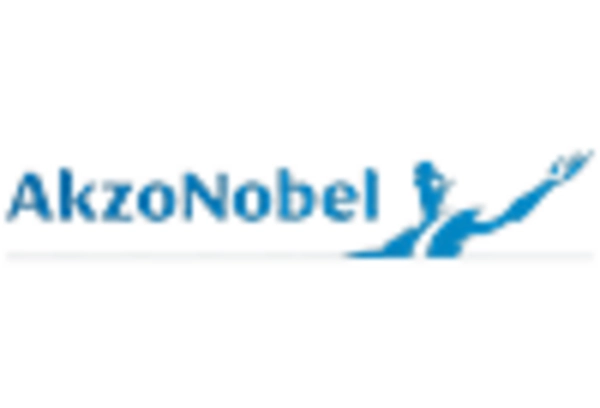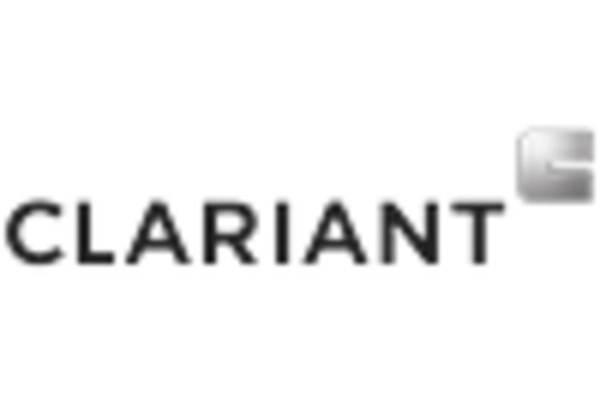-
Executive Summary
-
Scope of the Report
-
Market Definition
-
Scope of the Study
- Research Objectives
- Assumptions & Limitations
-
Market Structure
-
Market Research
-
Methodology
-
Research Process
-
Secondary Research
-
Primary
-
Research
-
Forecast Model
-
Market Landscape
-
Supply Chain Analysis
- Raw Material Suppliers
- Manufacturers/Producers
- Distributors/Retailers/Wholesalers/E-Commerce
- End Users
-
Porter’s Five Forces Analysis
- Threat
- Bargaining Power of Buyers
- Bargaining Power
- Threat of Substitutes
- Intensity of Competitive
-
of New Entrants
-
of Suppliers
-
Rivalry
-
Market Dynamics of the Global Non-Ionic Surfactants Market
-
Introduction
-
Drivers
-
Restraints
-
Opportunities
-
Challenges
-
Trends/Strategies
-
Global Non-Ionic Surfactants Market,
-
by Type
-
Introduction
-
Alcohol Ethoxylates
- Market Estimates
- Market Estimates & Forecast, by Region,
-
& Forecast, 2022–2030
-
Fatty Alkanolamides
- Market Estimates & Forecast,
- Market Estimates & Forecast, by Region, 2022–2030
-
Amine Derivatives
- Market Estimates & Forecast, 2022–2030
- Market Estimates & Forecast, by Region, 2022–2030
-
Glycerol
- Market Estimates & Forecast, 2022–2030
-
Derivatives
-
Market Estimates & Forecast, by Region, 2022–2030
-
Alkoxylates
- Market Estimates & Forecast, 2022–2030
- Market Estimates
-
& Forecast, by Region, 2022–2030
-
Others
- Market Estimates
- Market Estimates & Forecast, by Region,
-
& Forecast, 2022–2030
-
Global Non-Ionic Surfactants Market, by Application
-
Introduction
-
Cleaners
- Market Estimates & Forecast, 2022–2030
- Market Estimates & Forecast, by Region, 2022–2030
-
Emulsifiers
- Market Estimates & Forecast, 2022–2030
- Market Estimates
-
& Forecast, by Region, 2022–2030
-
Foaming Agents
- Market
- Market Estimates & Forecast,
-
Estimates & Forecast, 2022–2030
-
by Region, 2022–2030
-
Wetting Agents
- Market Estimates &
- Market Estimates & Forecast, by Region,
-
Forecast, 2022–2030
-
Additives
- Market Estimates & Forecast, 2022–2030
- Market Estimates & Forecast, by Region, 2022–2030
-
Others
- Market Estimates & Forecast, 2022–2030
- Market Estimates
-
& Forecast, by Region, 2022–2030
-
Global Non-Ionic Surfactants
-
Market, by End-Use Industry
-
Introduction
-
Paints & Coatings
- Market Estimates & Forecast, 2022–2030
- Market Estimates
-
& Forecast, by Region, 2022–2030
-
Personal Care & Cosmetics
- Market Estimates & Forecast, 2022–2030
- Market Estimates
-
& Forecast, by Region, 2022–2030
-
Textiles
- Market Estimates
- Market Estimates & Forecast, by Region,
-
& Forecast, 2022–2030
-
Agrochemicals
- Market Estimates & Forecast,
- Market Estimates & Forecast, by Region, 2022–2030
-
Household Cleaners
- Market Estimates & Forecast, 2022–2030
- Market Estimates & Forecast, by Region, 2022–2030
-
Food
- Market Estimates & Forecast, 2022–2030
-
& Beverage
-
Market Estimates & Forecast, by Region, 2022–2030
-
Oil & Gas
- Market Estimates & Forecast, 2022–2030
- Market Estimates
-
& Forecast, by Region, 2022–2030
-
Others
- Market Estimates
- Market Estimates & Forecast, by Region,
-
& Forecast, 2022–2030
-
Global Non-Ionic Surfactants Market, by Region
-
Introduction
-
North America
- Market Estimates & Forecast,
- Market Estimates & Forecast, by Type, 2022–2030
- Market Estimates & Forecast, by Application, 2022–2030
-
Market Estimates & Forecast, by End-Use Industry, 2022–2030
-
US
-
Estimates & Forecast, by Type, 2022–2030
-
& Forecast, by Application, 2022–2030
-
Forecast, by End-Use Industry, 2022–2030
-
Estimates & Forecast, 2022–2030
-
by Type, 2022–2030
-
Estimates & Forecast, by Application, 2022–2030
-
& Forecast, by End-Use Industry, 2022–2030
-
Market Estimates & Forecast, 2022–2030
-
Forecast, by Type, 2022–2030
-
by Application, 2022–2030
-
End-Use Industry, 2022–2030
-
& Forecast, 2022–2030
-
Type, 2022–2030
-
Market Estimates & Forecast, 2022–2030
-
Market
-
Market Estimates
-
Market Estimates &
-
Canada
-
Market
-
Market Estimates & Forecast,
-
Market Estimates & Forecast, by Application,
-
Market Estimates & Forecast, by End-Use Industry,
-
Europe
- Market Estimates & Forecast, 2022–2030
- Market Estimates & Forecast, by Type, 2022–2030
- Market
- Market Estimates
- Germany
- France
- Italy
-
Market Estimates & Forecast, by Application, 2022–2030
-
Estimates & Forecast, by End-Use Industry, 2022–2030
-
& Forecast, by Type, 2022–2030
-
by Application, 2022–2030
-
End-Use Industry, 2022–2030
-
Forecast, 2022–2030
-
Market
-
Spain
-
Market Estimates & Forecast, 2022–2030
-
Market Estimates
-
Market Estimates & Forecast,
-
Market Estimates & Forecast, by
-
UK
-
Market Estimates &
-
Market Estimates & Forecast, by Type,
-
Market Estimates & Forecast, by Application, 2022–2030
-
Market Estimates & Forecast, by End-Use Industry, 2022–2030
-
Russia
-
Market Estimates & Forecast, 2022–2030
-
Market Estimates & Forecast, by Type, 2022–2030
-
Market Estimates & Forecast, by Application, 2022–2030
-
Estimates & Forecast, by End-Use Industry, 2022–2030
-
Estimates & Forecast, by Type, 2022–2030
-
& Forecast, by Application, 2022–2030
-
Forecast, by End-Use Industry, 2022–2030
-
Market Estimates & Forecast, 2022–2030
-
& Forecast, by Type, 2022–2030
-
by Application, 2022–2030
-
End-Use Industry, 2022–2030
-
& Forecast, 2022–2030
-
Market
-
Poland
-
Market Estimates & Forecast, 2022–2030
-
Market
-
Market Estimates
-
Market Estimates &
-
Rest of Europe
-
Market Estimates
-
Market Estimates & Forecast,
-
Market Estimates & Forecast, by
-
Asia-Pacific
- Market Estimates
- Market Estimates & Forecast, by Type,
- Market Estimates & Forecast, by Application, 2022–2030
- Market Estimates & Forecast, by End-Use Industry, 2022–2030
- China
-
Market Estimates & Forecast, by Type, 2022–2030
-
& Forecast, by Application, 2022–2030
-
Forecast, by End-Use Industry, 2022–2030
-
Estimates & Forecast, 2022–2030
-
by Type, 2022–2030
-
Market Estimates
-
Market Estimates &
-
India
-
Market
-
Market Estimates & Forecast,
-
Market Estimates & Forecast, by Application,
-
Market Estimates & Forecast, by End-Use Industry,
-
Japan
-
Market Estimates & Forecast, 2022–2030
-
Market Estimates & Forecast, by Type, 2022–2030
-
Market Estimates & Forecast, by Application, 2022–2030
-
Estimates & Forecast, by End-Use Industry, 2022–2030
-
& New Zealand
-
Market
-
Australia
-
Market Estimates & Forecast, 2022–2030
-
Market Estimates & Forecast, by Type, 2022–2030
-
Market Estimates & Forecast, by Application, 2022–2030
-
Estimates & Forecast, by End-Use Industry, 2022–2030
-
& South Korea
-
Market
-
Indonesia
-
Market Estimates & Forecast, 2022–2030
-
Market Estimates & Forecast, by Type, 2022–2030
-
Market Estimates & Forecast, by Application, 2022–2030
-
Estimates & Forecast, by End-Use Industry, 2022–2030
-
of Asia-Pacific
-
Market
-
Rest
-
Market Estimates & Forecast, 2022–2030
-
Market Estimates & Forecast, by Type, 2022–2030
-
Market Estimates & Forecast, by Application, 2022–2030
-
Estimates & Forecast, by End-Use Industry, 2022–2030
-
& Africa
-
Market
-
Middle East
- Market Estimates & Forecast, 2022–2030
-
Market Estimates & Forecast, by Type, 2022–2030
-
& Forecast, by Application, 2022–2030
-
Forecast, by End-Use Industry, 2022–2030
-
Estimates & Forecast, 2022–2030
-
by Type, 2022–2030
-
Market Estimates
-
Market Estimates &
-
GCC
-
Market
-
Market Estimates & Forecast,
-
Market Estimates & Forecast, by Application,
-
Market Estimates & Forecast, by End-Use Industry,
-
Israel
-
Market Estimates & Forecast,
-
Market Estimates & Forecast, by Type, 2022–2030
-
Market Estimates & Forecast, by Application, 2022–2030
-
Market Estimates & Forecast, by End-Use Industry, 2022–2030
-
North Africa
-
Market Estimates & Forecast, 2022–2030
-
Market Estimates & Forecast, by Type, 2022–2030
-
& Forecast, by Application, 2022–2030
-
Forecast, by End-Use Industry, 2022–2030
-
Estimates & Forecast, 2022–2030
-
by Type, 2022–2030
-
Estimates & Forecast, 2022–2030
-
by Type, 2022–2030
-
Market Estimates
-
Market Estimates &
-
Turkey
-
Market
-
Market Estimates & Forecast,
-
Market Estimates & Forecast, by Application,
-
Market Estimates & Forecast, by End-Use Industry,
-
Rest of Middle East & Africa
-
Market
-
Market Estimates & Forecast,
-
Market Estimates & Forecast, by Application,
-
Market Estimates & Forecast, by End-Use Industry,
-
Latin America
- Market Estimates & Forecast,
- Market Estimates & Forecast, by Type, 2022–2030
- Market Estimates & Forecast, by Application, 2022–2030
-
Market Estimates & Forecast, by End-Use Industry, 2022–2030
-
Brazil
-
Market Estimates & Forecast, 2022–2030
-
Market Estimates & Forecast, by Type, 2022–2030
-
& Forecast, by Application, 2022–2030
-
Forecast, by End-Use Industry, 2022–2030
-
Estimates & Forecast, 2022–2030
-
by Type, 2022–2030
-
Market Estimates
-
Market Estimates &
-
Mexico
-
Market
-
Market Estimates & Forecast,
-
Market Estimates & Forecast, by Application,
-
Market Estimates & Forecast, by End-Use Industry,
-
Argentina
-
Market Estimates & Forecast,
-
Market Estimates & Forecast, by Type, 2022–2030
-
Market Estimates & Forecast, by Application, 2022–2030
-
Market Estimates & Forecast, by End-Use Industry, 2022–2030
-
Rest of Latin America
-
Market Estimates & Forecast, 2022–2030
-
Market Estimates & Forecast, by Type, 2022–2030
-
Market Estimates & Forecast, by Application, 2022–2030
-
Estimates & Forecast, by End-Use Industry, 2022–2030
-
Market
-
Company
-
Landscape
-
Introduction
-
Market Key Strategies
-
Key Development
-
Analysis
-
(Expansions/Mergers & Acquisitions/Joint Ventures/New Application
-
Developments/Agreements/Investments)
-
Company Profiles
-
3M
- Financial Updates
- Application/Business
- Key Strategies
- Key Developments
-
Company Overview
-
Segment Overview
-
SWOT Analysis
-
SABIC
- Company Overview
- Financial
- Application/Business Segment Overview
- Key Strategies
- Key Developments
- SWOT Analysis
-
Updates
-
Akzo Nobel N.V.
- Company Overview
- Financial Updates
- Application/Business
- Key Strategies
- Key Developments
-
Segment Overview
-
SWOT Analysis
-
Arkema
- Company Overview
- Financial
- Application/Business Segment Overview
- Key Strategies
- Key Developments
- SWOT Analysis
-
Updates
-
BASF SE
- Financial Updates
- Application/Business
- Key Strategies
- Key Developments
-
Company Overview
-
Segment Overview
-
SWOT Analysis
-
Clariant
- Company Overview
- Financial
- Application/Business Segment Overview
- Key Strategies
- Key Developments
- SWOT Analysis
-
Updates
-
Dow
- Company
- Financial Updates
- Application/Business Segment
- Key Strategies
- Key Developments
- SWOT
-
Overview
-
Overview
-
Analysis
-
Elementis plc
- Company Overview
- Financial
- Application/Business Segment Overview
- Key Strategies
- Key Developments
- SWOT Analysis
-
Updates
-
Evonik Industries
- Company Overview
- Financial Updates
- Application/Business
- Key Strategies
- Key Developments
-
AG
-
Segment Overview
-
SWOT Analysis
-
Huntsman International LLC
- Company Overview
- Financial Updates
- Application/Business Segment Overview
- Key Strategies
- Key Developments
- SWOT Analysis
-
Kao Corporation
- Company Overview
- Financial Updates
- Application/Business Segment Overview
- Key Strategies
- SWOT Analysis
-
Key Developments
-
Stepan Company
- Financial Updates
- Application/Business
- Key Strategies
- Key Developments
-
Company Overview
-
Segment Overview
-
SWOT Analysis
-
Conclusion
-
LIST OF TABLES
-
Global
-
Non-Ionic Surfactants Market, by Region, 2022–2030
-
North America:
-
Non-Ionic Surfactants Market, by Country, 2022–2030
-
Europe: Non-Ionic
-
Surfactants Market, by Country, 2022–2030
-
Asia-Pacific: Non-Ionic
-
Surfactants Market, by Country, 2022–2030
-
Middle East & Africa:
-
Non-Ionic Surfactants Market, by Country, 2022–2030
-
Latin America:
-
Non-Ionic Surfactants Market, by Country, 2022–2030
-
Global Non-Ionic
-
Surfactants Type Market, by Region, 2022–2030
-
North America:
-
Non-Ionic Surfactants Type Market, by Country, 2022–2030
-
Europe:
-
Non-Ionic Surfactants Type Market, by Country, 2022–2030
-
Table10 Asia-Pacific:
-
Non-Ionic Surfactants Type Market, by Country, 2022–2030
-
Table11 Middle
-
East & Africa: Non-Ionic Surfactants Type Market, by Country, 2022–2030
-
Table13 Latin America: Non-Ionic Surfactants Type Market, by Country, 2022–2030
-
Table13 Global Non-Ionic Surfactants Application Market, by Region, 2022–2030
-
Table14 North America: Non-Ionic Surfactants Application Market, by Country, 2022–2030
-
Table15 Europe: Non-Ionic Surfactants Application Market, by Country, 2022–2030
-
Table16 Asia-Pacific: Non-Ionic Surfactants Application Market, by Country, 2022–2030
-
Table17 Middle East & Africa: Non-Ionic Surfactants Application Market, by
-
Country, 2022–2030
-
Table18 Latin America: Non-Ionic Surfactants Application
-
Market, by Country, 2022–2030
-
Table19 Global Non-Ionic Surfactants End-Use
-
Industry Market, by Region, 2022–2030
-
Table20 North America: Non-Ionic
-
Surfactants End-Use Industry Market, by Country, 2022–2030
-
Table21 Europe:
-
Non-Ionic Surfactants End-Use Industry Market, by Country, 2022–2030
-
Table22
-
Asia-Pacific: Non-Ionic Surfactants End-Use Industry Market, by Country, 2022–2030
-
Table23 Middle East & Africa: Non-Ionic Surfactants End-Use Industry Market,
-
by Country, 2022–2030
-
Table24 Latin America: Non-Ionic Surfactants End-Use
-
Industry Market, by Country, 2022–2030
-
Table25 Global Type Market, by
-
Region, 2022–2030
-
Table26 Global Application Market, by Region, 2022–2030
-
Table27 Global End-Use Industry Market, by Region, 2022–2030
-
Table28
-
North America: Non-Ionic Surfactants Market, by Country
-
Table29 North America:
-
Non-Ionic Surfactants Market, by Type
-
Table30 North America: Non-Ionic Surfactants
-
Market, by Application
-
Table31 North America: Non-Ionic Surfactants Market,
-
by End-Use Industry
-
Table32 Europe: Non-Ionic Surfactants Market, by Country
-
Table33 Europe: Non-Ionic Surfactants Market, by Type
-
Table34 Europe: Non-Ionic
-
Surfactants Market, by Application
-
Table35 Europe: Non-Ionic Surfactants Market,
-
by End-Use Industry
-
Table36 Asia-Pacific: Non-Ionic Surfactants Market, by
-
Country
-
Table37 Asia-Pacific: Non-Ionic Surfactants Market, by Type
-
Table38
-
Asia-Pacific: Non-Ionic Surfactants Market, by Application
-
Table39 Asia-Pacific:
-
Non-Ionic Surfactants Market, by End-Use Industry
-
Table40 Middle East &
-
Africa: Non-Ionic Surfactants Market, by Country
-
Table41 Middle East &
-
Africa Non-Ionic Surfactants Market, by Type
-
Table42 Middle East & Africa
-
Non-Ionic Surfactants Market, by Application
-
Table43 Middle East & Africa:
-
Non-Ionic Surfactants Market, by End-Use Industry
-
Table44 Latin America: Non-Ionic
-
Surfactants Market, by Country
-
Table45 Latin America Non-Ionic Surfactants
-
Market, by Type
-
Table46 Latin America Non-Ionic Surfactants Market, by Application
-
Table47 Latin America: Non-Ionic Surfactants Market, by End-Use Industry
-
LIST
-
OF FIGURES
-
Global Non-Ionic Surfactants Market Segmentation
-
FIGURE
-
Forecast Research Methodology
-
Porter’s Five Forces Analysis
-
of the Global Non-Ionic Surfactants Market
-
Value Chain of the Global
-
Non-Ionic Surfactants Market
-
Share of the Global Non-Ionic Surfactants
-
Market in 2022, by Country (%)
-
Global Non-Ionic Surfactants Market,
-
Global Non-Ionic Surfactants Market Size by Types,
-
Share of the Global Non-Ionic Surfactants Market, by Type, 2022–2030
-
Global Non-Ionic Surfactants Market Size, by Application, 2022
-
FIGURE
-
Share of the Global Non-Ionic Surfactants Market, by Application, 2022–2030
-
Global Non-Ionic Surfactants Market Size, by End-Use Industry, 2022
-
Share of the Global Non-Ionic Surfactants Market, by End-Use Industry,

















Leave a Comment